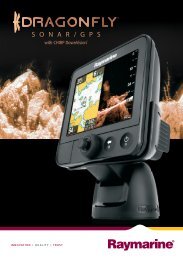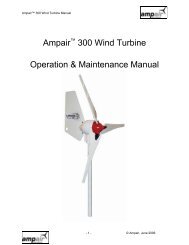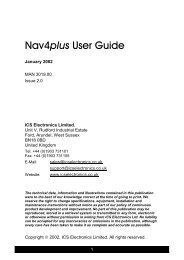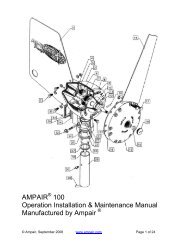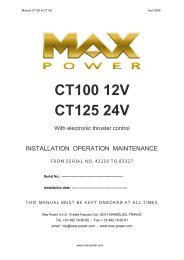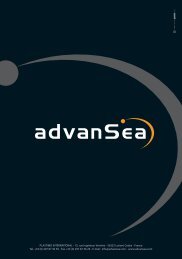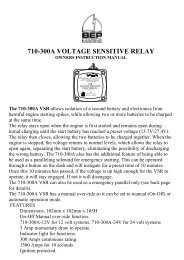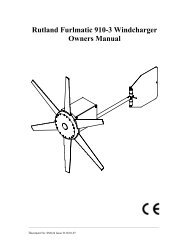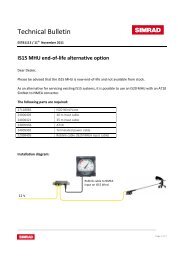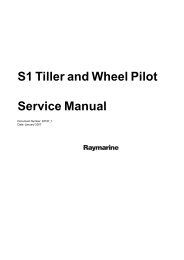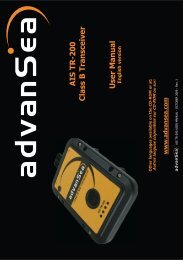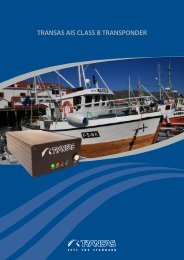User manual - JG Technologies
User manual - JG Technologies
User manual - JG Technologies
You also want an ePaper? Increase the reach of your titles
YUMPU automatically turns print PDFs into web optimized ePapers that Google loves.
4.1 General cabling guidance<br />
Cable types and length<br />
It is important to use cables of the appropriate type and length<br />
• Unless otherwise stated use only standard cables of the correct<br />
type, supplied by Raymarine.<br />
• Ensure that any non-Raymarine cables are of the correct quality<br />
and gauge. For example, longer power cable runs may require<br />
larger wire gauges to minimize voltage drop along the run.<br />
Routing cables<br />
Cables must be routed correctly, to maximize performance and<br />
prolong cable life.<br />
• Do NOT bend cables excessively. Wherever possible, ensure a<br />
minimum bend radius of 100 mm.<br />
4.2 Connections overview<br />
The connections for all multifunction display variants are listed<br />
below.<br />
e7<br />
e7D<br />
e95 / e125<br />
Minimum bend<br />
200 mm (8 in)<br />
diameter<br />
Minimum bend of cable<br />
100 mm (4 in) radius<br />
e97 / e127<br />
• Protect all cables from physical damage and exposure to heat.<br />
Use trunking or conduit where possible. Do NOT run cables<br />
through bilges or doorways, or close to moving or hot objects.<br />
c95 / c125<br />
• Secure cables in place using tie-wraps or lacing twine. Coil any<br />
extra cable and tie it out of the way.<br />
• Where a cable passes through an exposed bulkhead or deckhead,<br />
use a suitable watertight feed-through.<br />
c97 / c127<br />
• Do NOT run cables near to engines or fluorescent lights.<br />
Always route data cables as far away as possible from:<br />
• other equipment and cables,<br />
• high current carrying ac and dc power lines,<br />
• antennae.<br />
Transducer<br />
SeaTalk ng<br />
SeaTalk hs<br />
/RayNet<br />
Network<br />
1<br />
SeaTalk hs<br />
/RayNet<br />
Network<br />
2<br />
Video<br />
in/out<br />
D12249-2<br />
Power<br />
/ Video<br />
/ NMEA<br />
0183<br />
Strain relief<br />
e7<br />
Ensure adequate strain relief is provided. Protect connectors from<br />
strain and ensure they will not pull out under extreme sea conditions.<br />
e7D<br />
Circuit isolation<br />
e95<br />
Appropriate circuit isolation is required for installations using both<br />
AC and DC current:<br />
e97<br />
• Always use isolating transformers or a separate power-inverter<br />
to run PC’s, processors, displays and other sensitive electronic<br />
instruments or devices.<br />
• Always use an isolating transformer with Weather FAX audio<br />
cables.<br />
• Always use an isolated power supply when using a 3rd party<br />
audio amplifier.<br />
• Always use an RS232/NMEA converter with optical isolation on<br />
the signal lines.<br />
• Always make sure that PC’s or other sensitive electronic devices<br />
have a dedicated power circuit.<br />
Cable shielding<br />
e125<br />
e127<br />
c95<br />
c97<br />
c125<br />
c127<br />
Ensure that all data cables are properly shielded that the cable<br />
shielding is intact (e.g. hasn’t been scraped off by being squeezed<br />
through a tight area).<br />
32 e7 / e7D / e95 / e97 / e125 / e127 / c95 / c97 / c125 / c127




